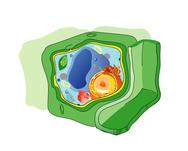 | ||||
Plant Cell Parts, Functions & Diagrams - P2
Image of generic plant celll. Click here for a labeled diagram of this cell.
Page last updated: 1/2016
SPO VIRTUAL CLASSROOMS
The Virtual Cell Biology Classroom provides a wide range of free educational resources including Power Point Lectures, Study Guides, Review Questions and Practice Test Questions.
PAGE 3 < Back to Page 2
Other Eukaryotic Cell Components & Organelles
- Mitochondria: Tiny powerhouses of the cell, these double membrane-bound organelles transform food energy into ATP (adesnosine-5’- triphosphate), an all-purpose cellular energy nucleotide, analogous to a rechargeable battery, that can be used for work within the cell.
- Cytoplasm: The contents of the cell, between the nucleus and plasma membrane, consist of a gel-like fluid in which the organelles are suspended.
Sources and Helpful Plant Cell Resources
- Becker, W. M. et. al. (2009) The World of the Cell. Pearson Benjamin Cummings.
- Campbell, N. & Reece, J. (2002) Biology, Sixth Edition. Benjamin Cummings.
- Eukaryotic Cell Structure & Function Lecture Main Page from the Virtual Cell Biology Classroom.
- Interactive Eukaryotic Cell Model from Cells Alive.com
- Interactive Plant and Animal Cell Simulation by ForgeFX Simulations
- Cell Structure Interactive Animation from Wiley.com
VIDEO
Plant Cells
from
Crash Course Biology
 | ||||||
SPO is a FREE science education website. Donations are key in helping us provide this resource with fewer ads.
Please help!
(This donation link uses PayPal on a secure connection.)
- Cytoskeleton: This network of filaments and tubules spans the interior of the cell. The cytoskeleton provides support, anchors organelles, and helps with transport of materials within the cell.
- Centrosomes: In plants cells, the centrosome does not contain centrioles like in animal cells, but does function to build microtubules (a component of the cytoskeleton) and is called the microtubule organizing center.


